In this 15th episode of the Football History Rewind, we discuss the season of 1893 where the forwards tightened up their gaps and the defenses were taught the scoop and score. These concepts as well as many more legendary stories.
Football 1893
Football 1893
The Football Strategists Go to Work
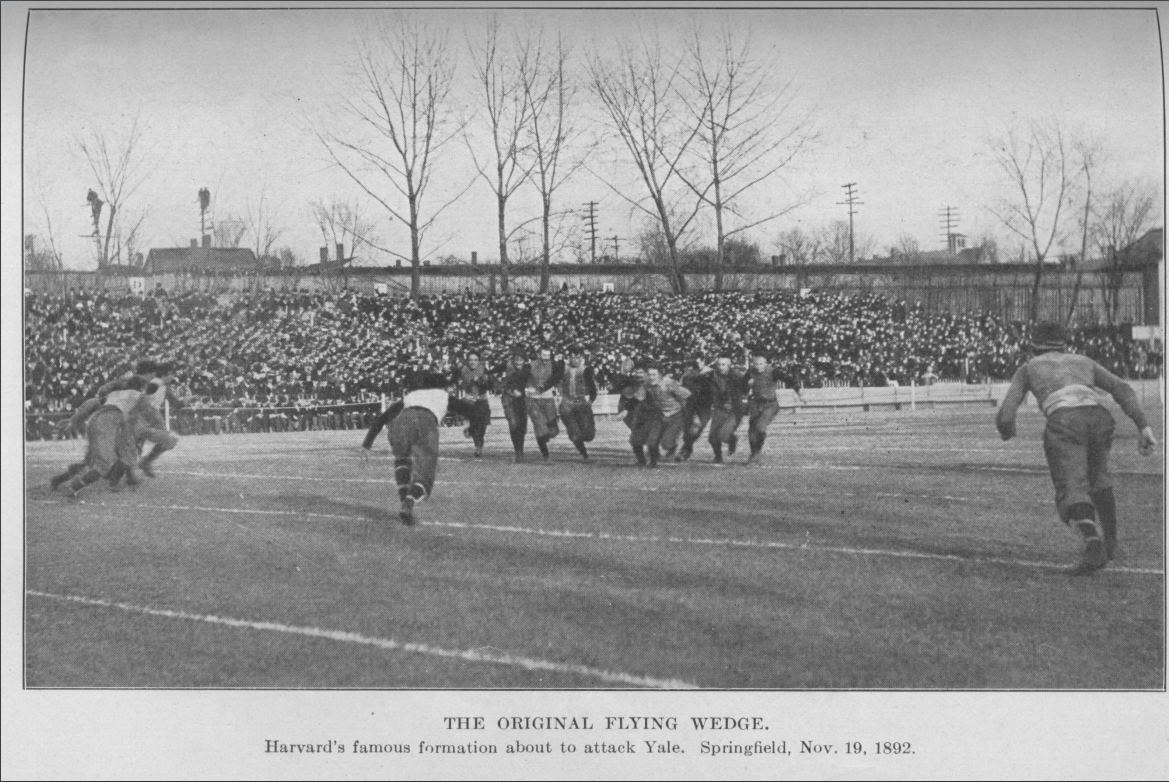
Photo is from Parke H. Davis 1911 book: Football - The American Intercollegiate Game of the Flying Wedge in action
When we last left the history lesson of football in this series at the conclusion of Part 14 of this football history series it was learned that a formation called the “Flying Wedge” was becoming a dominant strategy by many teams. This Wedge formation was looked at as an illness of the game and many had in mind to stop its use in the early 1890’s and quickly.
1893 brings more strategic milestones
The advent of new strategies was really gathering steam in early 1893 and it all sort of started with the new coach of Yale. George W. Woodruff had recently become the coach of Yale after leaving rival Pennsylvania. Woodruff with his new team revolutionized some old basic concepts of football and made rival teams scratch their heads on coming up with new ways to counter the new concepts.
Offensively Woodruff had his Yale forwards (now called lineman) much closer together in their initial line ups against opponents on plays. He also taught these players to penetrate the line and push defensive rushers towards the sidelines and not towards a central “pocket” as was the strategy of most blockers of that time. This concept became known as the “mass momentum “plays.

The 1893 Auburn University Football Team in formation, courtesy Wikimedia Commons. Taken by an unknown photographer.
Other radical ideas for this era instituted by Woodruff were to try to pick up a fumble and get a long scoring return rather than the old dive on the ball routine practiced by opponents. Woodruff is also credited with what was known as the quarterback-kick which was the precursor to the onside-kick.
The single most important principal he started though was what was known at the time as “flying interference.” This is the concept of having defenders moving in mass before the snap in order to gain an advantage over the offensive blockers who even on that day had to remain pretty much stationary prior to the snap. The bold innovation caused confusion and anxiety on the offensive players and was a very effective strategy that soon most teams would adopt.
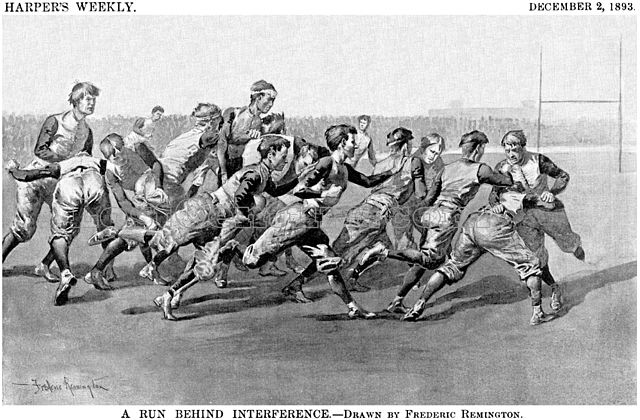
Courtesy Wikimedia Commons. Harper's Weekly Dec. 2, 1893 illustrated by Fredrick Remington.
DeLand of Harvard had a few things for Yale
Harvard had a football genius of their own, Lorin F. DeLand, who masterminded some innovation into the game of football as well. First DeLand had Harvard surprise rival Yale for their contest of November 25, 1893 by the entire Harvard squad wearing smooth leather one-piece suits that would make them slippery and harder to tackle. This was not totally a new concept as years earlier one nameless football strategist caused rule changes when he entered a championship game as a halfback who greased his body from his shoulders to his knees. This prompted a rule change which stated,” No sticky or greasy substance shall be used on the persons or clothing of the players.” DeLand was not in violation of the rule though as his players simply wore slippery smooth leather to try to gain the same advantage now the illegal grease did.
DeLand pulled out another gem for Yale in this same game which was called the “turtle-back” play. The Turtle-back play had the eleven offensive players form a solid oval which was concentrated against one point of the defensive rush line, usually a tackle, before the ball become live. From the air it would look almost like a human spiral. When the ball was snapped the oval-spiral would unwind towards a sideline. The interior of the oval contained the ball carrier and he would be rid of most interference by his blockers ahead of him in the unwinding human hurricane.
Another devised play by Harvard in this game was the “push-play.” The formation started in a similar fashion to that of the turtle-back but the difference would be that the runner would be lifted up by his teammates and tossed overtop and beyond the wall of blockers and rushers.
Woodruff has something up his sleeve for Harvard too
The crafty Yale coach would not be outdone on the scheming front in this game however. He had a few tricks of his own to unveil against Harvard. First he varied and tweaked his mass momentum style of offense as he had his entire line except the center and the guards withdraw from the line to a point fifteen yards behind the ball. The retracted linemen along with the backs formed a wedge that started moving forward towards the line before the snap. The wedge of players would focus on one point of the line to hit and as one can imagine it was a very effective strategy for poking a hole in the defensive line.
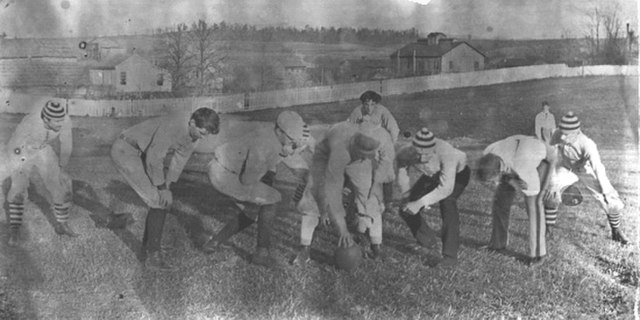
V.A.M.C. Football Team, 1893, coached by Prof. E.A. Smyth, Jr. (Virginia Tech was known as "Virginia Agricultural and Mechanical College" at the time.) Courtesy Wikimedia Commons.
The most important new strategic innovation that was introduced to the game in 1893 was that from Philip King of Princeton. King was a player for Princeton in 1893 and his idea was one that was used by most teams from the mid 1890’s until well into the twentieth century. The idea was to line an end and a back directly behind an offensive tackle.
Harvard tweaked the tandem tackle concept a few weeks later in their game where the tackle was off the line a few yards too before the snap. The next season and beyond would see the tandem–tackle formation be the formation of choice by most teams on most plays.
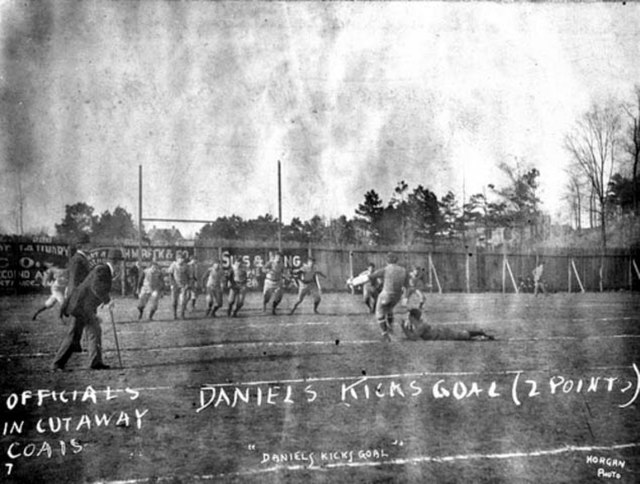
The 1893 Auburn University Football Team in kicking formation, courtesy Wikimedia Commons. Taken by an unknown photographer.
The new concepts had some drawbacks to them as well. Unfortunately we are out of time in this edition of football history so please come back and join us when Part 16 hits the pages of PigskinDispatch.com to continue the story.
We are able to give this in depth look from so long ago in history by careful research. Using someone who was contemporary to the period is the best source. So a very special shout out to our main source of reference information for this article is from Parke H. Davis in his 1911 book Football-The American Intercollegiate Game.
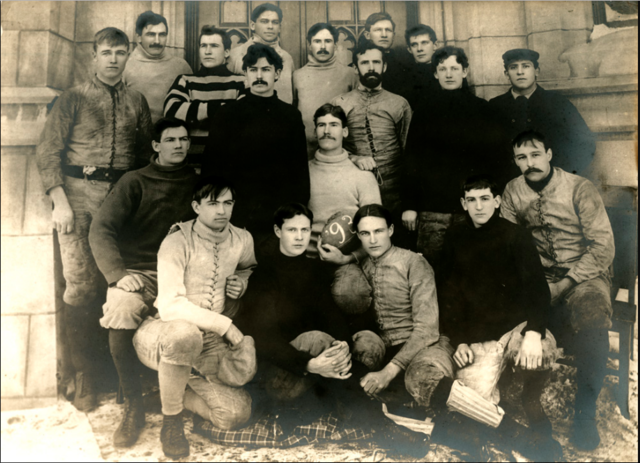
The 1893 Purdue University Football Team, courtesy Wikimedia Commons. Taken by an unknown photographer.
Photo Credits
The picture in the banner above is from the Wikimedia Commons' collection and is a illustration from the December 2, 1893- Harper's Weekly Magazine by Fredrick Remington, titled Running Behind Interference. Other photos above are also from the Wikimedia Commons' collection of teams and plays druing 1893 by unknown photographers.





